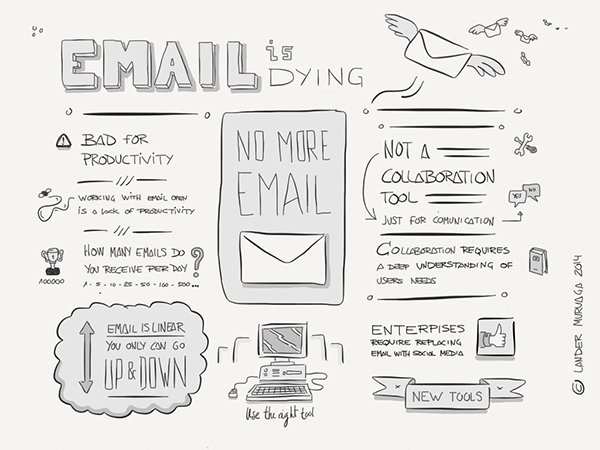Email is known to be an unbeatable tool for instant communication. However, within businesses and with frequent collaborators, it isn’t really the best way to work together anymore. As soon as a collaborative tool came along, it started a real revolution in the way we organize work and how we work together.
To be clear, we are not saying that email has no place at the heart of a business, not at all, in one-to-one dialogues it is indispensable. But for optimal organization, it is no longer the best option.
Why has email lost its edge?

Source : Infography created by Lander Muruaga
Studies show that email is being used less. Really! Why? Well simply because it doesn’t handle the management and planning of projects within a company as well as a collaborative tool does.
Email wastes time. Have you ever tried to keep tabs on a topic/conversation in your inbox and then lose the thread and have to search for it all over again? You need to comb through subjects, senders, dates and topics, often complicated by multiple conversations/topics sent by the same person in order to find it again. Every day, in any line of work, you can receive hundreds of emails, how do you sort through them and organize them or avoid deleting important mails by mistake?
In short, email allows you to communicate but not to collaborate. It is a linear exchange. Which is why we need a collaborative tool.
Why use a collaboration tool?
Because it’s better! The advantages are numerous.
You can plan and follow the progress your projects, fully manage your projects by citing a start date, end date or completed stages… With a single action all of the people involved; collaborators, employees have access to updates and progress on the shared project/s.
By centralizing the management of your tasks, your entire team can work cooperatively. Assign tasks individually or to a group; everyone will know exactly what to do, how to do it and by when. Manage your workload and that of your employees and you will increase efficiency because you avoid constantly passing information back and forth.
Lastly, a collaboration tool that implicates all your employees encourages teamwork and a sense of unity, improving communications within your company and leaves a reliable record of what has taken place.
Do you want to improve the quality of everyone’s work? Long live collaboration!